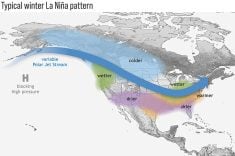Consumers traveling from the Vancouver area to Seattle, Wash., to stock up on cheap groceries should steer away from the milk section, says the Canadian dairy farmer lobby.
Otherwise, they’ll end up paying close to 50 percent more for their dairy products.
Shoppers from Mississauga, Ont., are similarly advised to steer clear of supermarkets in upstate New York. There, a basket of dairy products costs about 40 percent more.
Dairy Farmers of Canada released the numbers last week as part of its seventh cross-border dairy product price comparison since 1996.
Read Also

Saskatchewan throne speech promises strong economy
Saskatchewan’s legislative agenda for the coming year will focus on meeting the challenges of new world trading relationships, said the speech from the throne.
In each of the surveys, when American prices for similar products were converted to Canadian dollars, the American price was significantly higher.
The DFC says this proves the critics of supply management are wrong when they argue the system artificially inflates Canadian prices.
“The numbers speak for themselves,” said DFC president John Core in a statement released last week. “Canadian consumers are getting a great deal on Canadian dairy products. Consumers can thank producer price stability for very reasonable prices.”
By contrast, the DFC survey has shown that in the United States, farm-gate milk prices fluctuate but the downward swings are not always reflected at the supermarket.
American prices rise
In November 1998, U.S. milk prices paid to farmers reached their second highest level ever and consumer prices rose.
Between December and May, milk prices at the farm fell 34 percent but just a fraction of that was passed on to consumers.
The dairy farmer survey compared the cost of four different dairy product baskets containing an array of different products. Comparisons were made between sites in Ontario and New York, B.C. and Washington state, New Brunswick and Maine, and Quebec and Vermont.
The difference in price ranged from 8.74 percent between New Brunswick and Maine to the 50.86 percent advantage for B.C. shoppers.
Core, recently named president of DFC, said the survey results show the benefits of the supply management system, in which prices are tied to costs of production. Stable farm level prices and quota mean a steady supply of milk at predictable prices.
“The Canadian consumer pays 38.67 percent less than the American consumer for the same basket of dairy goods. This isn’t just a coincidence.”














